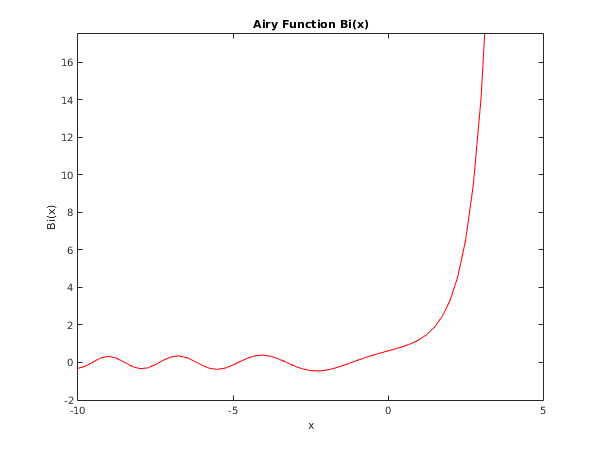PDF version (NAG web site
, 64-bit version, 64-bit version)
NAG Toolbox: nag_specfun_airy_bi_real (s17ah)
Purpose
nag_specfun_airy_bi_real (s17ah) returns a value of the Airy function, , via the function name.
Syntax
Description
nag_specfun_airy_bi_real (s17ah) evaluates an approximation to the Airy function . It is based on a number of Chebyshev expansions.
For
,
where
and
and
are expansions in the variable
.
For
,
where
and
are expansions in
.
For
,
where
is an expansion in
.
For
,
where
is an expansion in
.
For
,
where
and
is an expansion in
.
For , the result is set directly to . This both saves time and avoids possible intermediate underflows.
For large negative arguments, it becomes impossible to calculate the phase of the oscillating function with any accuracy so the function must fail. This occurs if
, where
is the
machine precision.
For large positive arguments, there is a danger of causing overflow since Bi grows in an essentially exponential manner, so the function must fail.
References
Abramowitz M and Stegun I A (1972) Handbook of Mathematical Functions (3rd Edition) Dover Publications
Parameters
Compulsory Input Parameters
- 1:
– double scalar
-
The argument of the function.
Optional Input Parameters
None.
Output Parameters
- 1:
– double scalar
The result of the function.
- 2:
– int64int32nag_int scalar
unless the function detects an error (see
Error Indicators and Warnings).
Error Indicators and Warnings
Errors or warnings detected by the function:
-
-
x is too large and positive. On soft failure, the function returns zero.
-
-
x is too large and negative. On soft failure, the function returns zero.
-
An unexpected error has been triggered by this routine. Please
contact
NAG.
-
Your licence key may have expired or may not have been installed correctly.
-
Dynamic memory allocation failed.
Accuracy
For negative arguments the function is oscillatory and hence absolute error is the appropriate measure. In the positive region the function is essentially exponential-like and here relative error is appropriate. The absolute error,
, and the relative error,
, are related in principle to the relative error in the argument,
, by
In practice, approximate equality is the best that can be expected. When
,
or
is of the order of the
machine precision, the errors in the result will be somewhat larger.
For small
, errors are strongly damped and hence will be bounded essentially by the
machine precision.
For moderate to large negative , the error behaviour is clearly oscillatory but the amplitude of the error grows like amplitude .
However the phase error will be growing roughly as and hence all accuracy will be lost for large negative arguments. This is due to the impossibility of calculating sin and cos to any accuracy if .
For large positive arguments, the relative error amplification is considerable:
This means a loss of roughly two decimal places accuracy for arguments in the region of
. However very large arguments are not possible due to the danger of causing overflow and errors are therefore limited in practice.
Further Comments
None.
Example
This example reads values of the argument from a file, evaluates the function at each value of and prints the results.
Open in the MATLAB editor:
s17ah_example
function s17ah_example
fprintf('s17ah example results\n\n');
x = [-10 -1 0 1 5 10 20];
n = size(x,2);
result = x;
for j=1:n
[result(j), ifail] = s17ah(x(j));
end
disp(' x Bi(x)');
fprintf('%12.3e%12.3e\n',[x; result]);
s17ah_plot;
function s17ah_plot
x = [-10:0.25:3.25];
for j = 1:numel(x)
[Bi(j), ifail] = s17ah(x(j));
end
fig1 = figure;
plot(x,Bi,'-r');
xlabel('x');
ylabel('Bi(x)');
title('Airy Function Bi(x)');
axis([-10 5 -2 17.5]);
s17ah example results
x Bi(x)
-1.000e+01 -3.147e-01
-1.000e+00 1.040e-01
0.000e+00 6.149e-01
1.000e+00 1.207e+00
5.000e+00 6.578e+02
1.000e+01 4.556e+08
2.000e+01 2.104e+25
PDF version (NAG web site
, 64-bit version, 64-bit version)
© The Numerical Algorithms Group Ltd, Oxford, UK. 2009–2015
